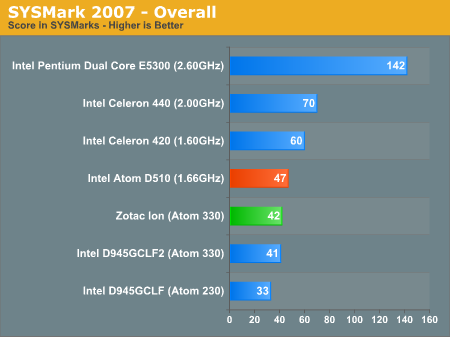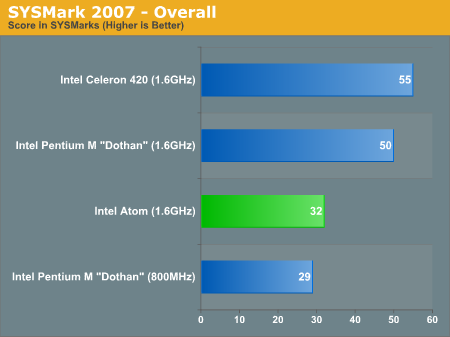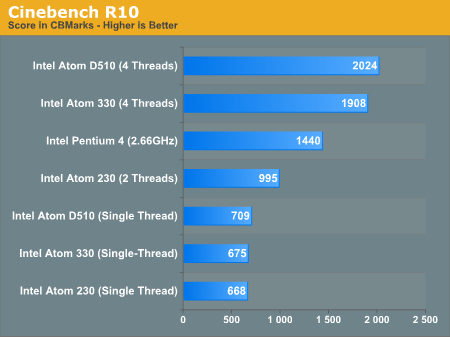Intel Atom D510: Pine Trail Boosts Performance, Cuts Power
by Anand Lal Shimpi on December 21, 2009 12:01 AM EST- Posted in
- CPUs
Performance
Across the board, thanks entirely to the integrated memory controller, Pine Trail is roughly 5 - 10% faster than the original Atom platform. The performance gain varies, but on average I’d say 5 - 10% is a reasonable expectation. It’s lower than I expected, but it looks like Atom’s performance is gated in more areas than just memory operations.

The integrated GMA 3150 feels like it handles Windows Aero a bit worse than Ion at higher resolutions, but I hear that may be a driver issue.
That 5 - 10% performance advantage does actually translate into something you can feel in real world usage. My Pine Trail system felt snappier than my older Atom machines. By no means was it fast, Atom is still slow after all, integrated memory controller or not.
Remember the comparison I did back in 2008:

At 1.6GHz the old single core Atom delivered the performance of roughly a 1.2GHz Pentium M. Thanks to the integrated memory controller I’d put the new Atom D410 at about the speed of a 1.4GHz Pentium M. The dual-core D510 is a bit more difficult to quantify. In single threaded use cases, the D510 still fits the bill as a 1.4GHz Pentium M, move to multithreaded and it’ll clearly have an advantage there.
Interacting with your PC, opening windows, launching apps, browsing the web, is generally all bound by the performance of a single thread. In those cases, you’re still looking at a platform that’s the equivalent of a low end notebook (not desktop) from 2004.

Atom has single threaded performance worse than a Pentium 4, but multithreaded FP/SSE performance can be much better on the dual core versions
The second core helps Atom not feel so slow when you’re trying to do two things at once. The second task doesn’t even have to be that CPU intensive, it could be something as simple as reading a document while you’re launching another application or opening another web page. Even in light multitasking, the second core helps.
On average, it’s still a sluggish platform. I’d take Pine Trail over the old Atom any day, but set your expectations accordingly: Atom can’t deliver the performance of a modern day machine, it’s best used as a secondary or tertiary PC.
Test Configuration
| Motherboard: | Intel D945GCLF2 (Atom 330) Intel D945GCLF (Atom 230) Intel D510MOB (Atom D510) Zotac Ion (Atom 330) |
| Chipset Drivers: | Intel 9.1.1.1011 (Intel) |
| Hard Disk: | Intel X25-M SSD (80GB) |
| Memory: | G.Skill DDR2-800 2 x 2GB (4-4-4-12) 2GB for the two Intel Atom 330/230 boards |
| Desktop Resolution: | 1920 x 1200 |
| OS: | Windows Vista Ultimate 32-bit (for SYSMark) Windows Vista Ultimate 64-bit |










41 Comments
View All Comments
Jeffk464 - Monday, December 21, 2009 - link
This might be a decent solution with the broadcom media chip making it capable of playing HD content and hopefully flash media.dealcorn - Monday, December 21, 2009 - link
If I am reading correctly the Intel platform with Broadcom media accelerator (about $25) is cheaper than the Ion platform and will consume less energy. Some relevant perfortmance testing may help determine whether the Intel platform is positioned to dominate the frugal HTPC market.It is a bummer that you will need to spend chump change for a SATA port card to enable software raid 5 for a frugal media server.
Likely, the incremental performance improvements are adequate for Intel to maintain its cachet in the dissed, real world netbook market with its surprisingly large volumes.
Its kinda a nothing platform, but in context may be a home run.
Jeffk464 - Monday, December 21, 2009 - link
For it to be a solution for me it needs to be on a mobo that has a pcie slot and hdmi through the broadcom chip. I'm not to hopeful though, will probably end up with a i3 solution. Too bad, I like the idea of going super low wattage.psychobriggsy - Monday, December 21, 2009 - link
The platform is standing still apart from getting more integrated. Hopefully that will mean cheaper. Maybe some netbooks will get cheaper, but otherwise the platform is a complete waste of time because of the lack of HD video capability (for Intel to call the graphics "HD Graphics" is verging on consumer misrepresentation, it can't even do 1080p output via HDMI/DVI, what is this, 2005?).Why did the review concentrate on benchmarks of applications nobody would run on such a system?
These chips are a solution for nothing apart from the unwealthy Office user who needs 8 hours of battery instead of 6.
Jeffk464 - Monday, December 21, 2009 - link
It can be used for a low power/cost network storage device.Zool - Monday, December 21, 2009 - link
There could be a test with underclocked and undervolted E5300 against the Atom D510. Maybe Power vs performance would be quite close if not better for the E5300. I think that everyone could take another 10W for a performance thats not crapy (even netbooks).Calin - Monday, December 21, 2009 - link
10 more watts would mean going from 8-9 hours of socket-free operation down to 6 (or maybe less). Not acceptable for the people that want 8 hours of socket-free operation. As for higher performance CPU, you have the low voltage processors (CULV), which will better fit the bill.Zool - Monday, December 21, 2009 - link
Thing is that 10+ more wats in CPU doesnt mean that u use it all the time. For internet browsing and so (not like u can use it efectivly for something more) the cpu isnt working 100% all the time just sporadicly.Majority of the power usage in those scenarios is in the rest of the hardware like display ,gpu, mainboard which runs all the time.
And i dont even say that with faster cpu the task are faster done so u use the cpu on 100% state less time in total.
Atom is the only one of its kind now and without competition it will stay this crapy for long time.
cjs150 - Monday, December 21, 2009 - link
There are 3 markets for this type of product: notebooks, HTPC and cheap file servers:HTPC market: complete failure because the graphics are not up to scratch
Cheap file server: only SATA ports but I could add my raid card to this but the given the cost it would be cheaper to buy a NAS box
Notebooks: barely adequate - word processing and simple internet browsing only.
So for 2 out of 3 markets it is a waste of space and the 3rd market it is merely sub-par what is already out there
Jeffk464 - Monday, December 21, 2009 - link
Don't give up yet, mobo manufacturers have the option to put a broadcom media chip on their boards. I don't know if this will come with HDMI though. Have to wait and see.